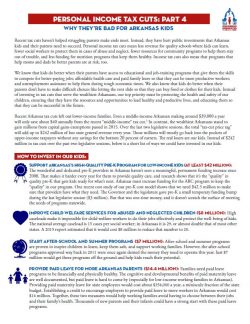
Recent tax cuts haven’t helped struggling parents make ends meet. Instead, they have hurt public investments that Arkansas kids and their parents need to succeed. Personal income tax cuts mean less revenue for quality schools where kids can learn, fewer social workers to protect them in cases of abuse and neglect, fewer community programs to help them stay out of trouble, and less funding for nutrition programs that keep them healthy. Income tax cuts also mean that programs that help moms and dads be better parents are at risk, too.
Instead of investing in tax cuts that serve the wealthiest Arkansans, our top priority must be protecting the health and safety of our children, ensuring that they have the resources and opportunities to lead healthy and productive lives, and educating them so that they can be successful in the future. Instead of $242 million in tax cuts over the past two legislative sessions, below is a short list of ways we could have invested in our kids:
- Support Arkansas’s high-quality pre-K program for low-income kids (at least $42 million): The wonderful and dedicated pre-K providers in Arkansas haven’t seen a meaningful, permanent funding increase since 2008. That makes it harder every year for them to provide quality care, and research shows that it’s the “quality” in quality pre-K that gets kids ready for what’s next. One recent cost study of our pre-K model shows that we need $42.5 million to make sure that providers have what they need. The Governor and the legislature gave pre-K a small temporary funding bump during the last legislative session ($3 million). But that was one-time money, and it doesn’t scratch the surface of meeting the needs of programs statewide.
- Improve child welfare services for abused and neglected children ($8 million): High caseloads make it impossible for child welfare workers to do their jobs effectively and protect the well-being of kids. The national average caseload is 15 cases per social worker; in Arkansas it is 29, or almost double that of most other states. A 2015 report estimated that it would cost $8 million to reduce that number to 20.
- Start after-school and summer programs ($7 million): After-school and summer programs are proven to inspire children to learn, keep them safe, and support working families. However, the after-school programs approved way back in 2011 were once again denied the money they need to operate this year. Just $7 million would get these programs off the ground and help kids reach their potential.
- Provide paid leave for more Arkansas parents ($14.4 million): Families need paid leave programs to be financially and physically healthy. The cognitive and developmental benefits of paid maternity leave are well documented, but paid leave is hard to come by (especially for low-income working families in Arkansas). Providing paid maternity leave for state employees would cost only about $354,000 a year, a fraction of the state budget. Establishing a credit to encourage employers to provide paid leave to more workers in Arkansas would cost $14 million. Together, these two measures would help working families avoid having to choose between their jobs and their family’s health.
- Help kids stay on the right track ($10 million): A plan to provide proven-effective, community-based alternatives to juvenile incarceration was grounded when the Department of Youth Services (DYS) failed to receive adequate funding in 2015. Instead of the requested $10 million to reduce juvenile incarceration, DYS saw a $500,000 budget cut. Before that happened, DYS was already running lean because of the end of about $1.6 million in stimulus funding. You shouldn’t expect to see any improvements in juvenile incarceration until Arkansas lawmakers decide to invest in programs for kids.
In the final installment of our 4-part series on the effects of personal income tax cuts, we discuss the detrimental effects of cuts on our children, and elaborate on the above suggestions for investing in our future.
Click the download link to view the complete one-pager.
To see the full picture of how tax cuts affect Arkansas, review part 1, part 2 and part 3 of this series.
